Australia’s Part-Time Work Hotspots
We looked at 15 years of Census data to find which Australian cities are home to the highest percentage of part-time workers – and why.
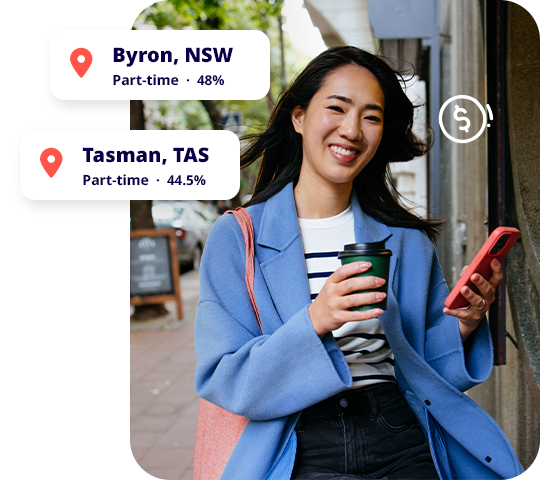
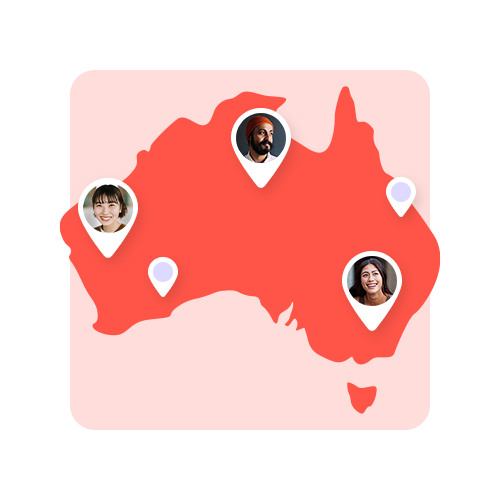
New Data: Australia leads part-time work trend
Forty years ago, around one in 10 employees worked part-time. Today, more than a quarter (30.8%) of Australian workers fit this description, equating to 4,388,800 people. And the part-time employment rate keeps growing, having risen by 63.4% from 2006.
To discover where Australia has the highest percentage of part-time workers, Reckon’s team of experts analysed 15 years of census data from 2006 to 2021 to discover Australia’s part-time working “hotspots”. Let’s dive in.
More men have multiple jobs, including part-time work
Despite the fact that nearly twice as many Australian women work part-time compared to men (2.6 million women versus 1.4 million men), men have driven the largest increase (32.1%) in part-time employment. Now, one-fifth (21.4%) of men in the workforce pursue part-time work. The number of men holding multiple jobs has also increased by over 30% in the past five years.
There may be a few reasons why. The rising cost of living is driving more men to take on multiple jobs, and the difficulty in finding full-time employment is increasing, driving individuals to seek multiple part-time positions to address their financial needs.

Gen Z makes up a quarter of Australia’s part-time workforce
Generation Z and Young Millennials (aged 15-34) had the most significant increase in part-time employment. This age group is more likely to have more than one source of income. Almost a quarter (22.8%) of part-time workers are between 15 and 24 years old.

Which Australian states have the most part-time workers?
Tasmania boasts the highest proportion of part-time workers (36.4%) and the highest increase in part-time workers (18.4%), thanks to its many part-time-friendly industries such as hospitality, retail, and healthcare. On the other hand, the Northern Territory has the lowest percentage of part-time workers (22.8%), as well as the lowest growth over the period (3.1%).
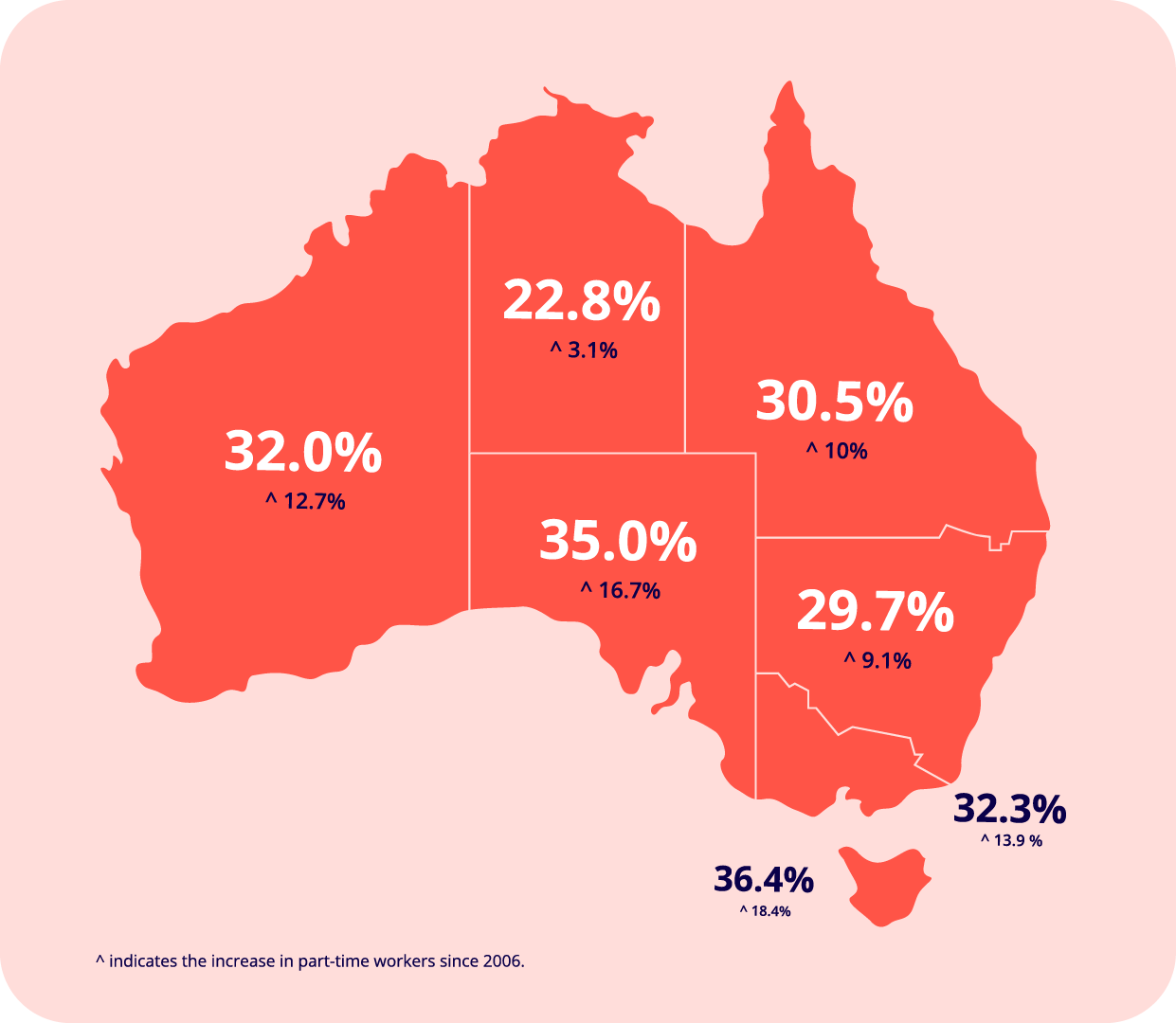
The top 10 part-time work hotspots in Australia
Famous for its laid-back vibe and hippie roots, it’s no surprise Byron Bay ranks first in Australia’s part-time work hotspots. The small beachside town draws both Aussies and international visitors to the area in search of a higher quality of life and better work-life balance. This may explain why almost half of workers (48%) choose part-time employment. The town is also a hub of cafes, hotels, yoga studios, shops and the arts, all of which lend to part-time work. Byron Bay is also loved by digital nomads, who often opt for part-time work while embracing the coastal lifestyle.

The top 10 part-time work hotspots by state
New South Wales
The majority of the top 10 part-time work hotspots in New South Wales are located along the Central and North Coast. Byron takes the top spot of the most common places to work part-time, followed by coastal council areas such as Nambucca Valley, Eurobodolla, and Coffs Harbour. What do these towns have in common? A chilled atmosphere and slow pace of life home to industries popular with part-time workers, such as hospitality and retail.

Victoria
Mount Alexander is named Victoria’s part-time hotspot, with 43.2% of employees working part-time. The area is home to an ageing population who typically favour part-time work. Coastal towns Queenscliff and Bass Coast follow in second and third place, respectively. Alongside coastal locations, numerous areas in regional Victoria, such as Alpine, East Gippsland, and South Gippsland, rank in the top 10.
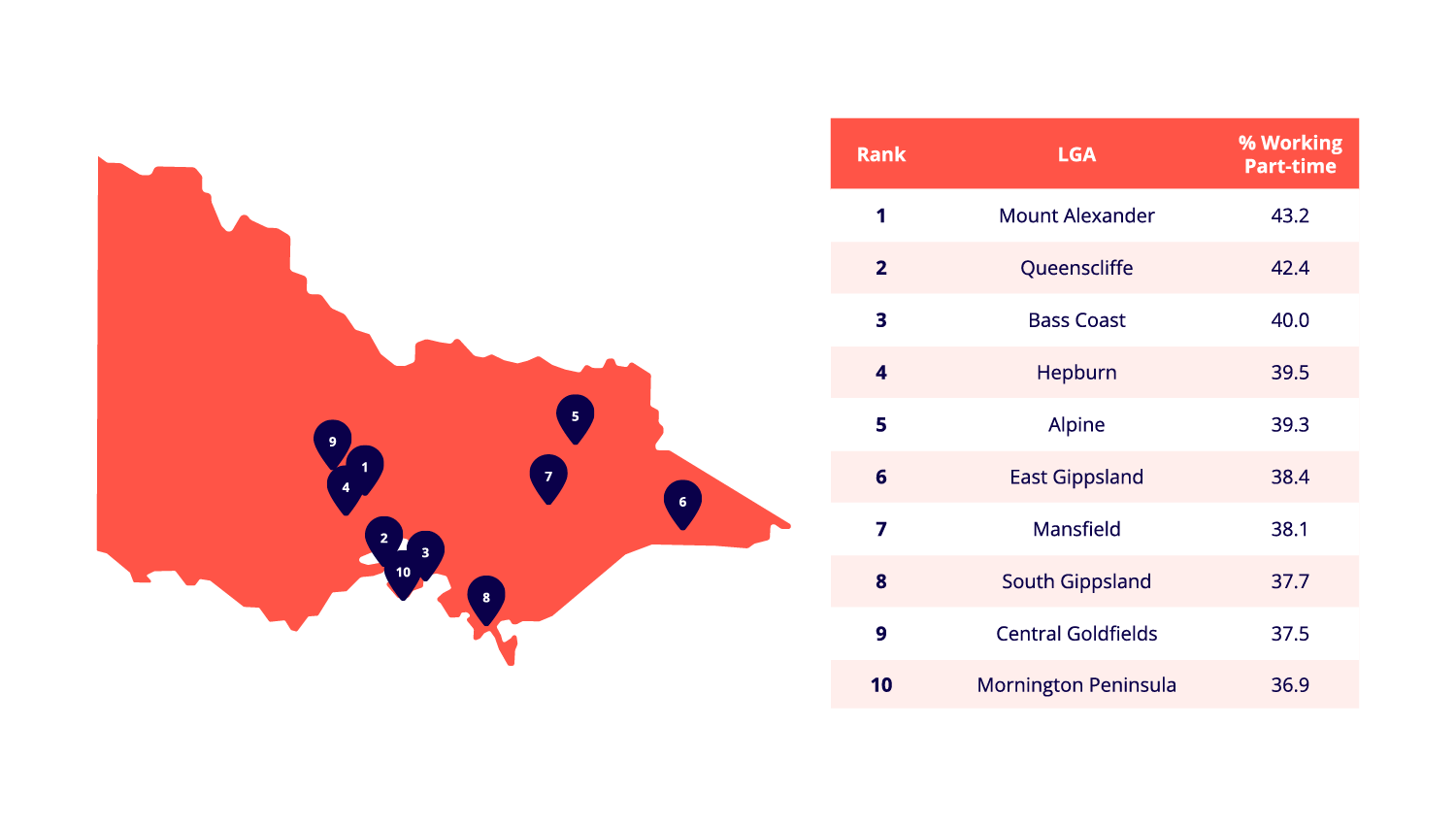
Queensland
Noosa is home to the highest percentage of part-time workers in Queensland, with almost two in five (39.5%) employees working part-time. Noosa is well known for its peaceful and relaxed nature, perfect for those seeking a balance between work and life. Further up the coast, Douglas, a suburb of Townsville, ranks second place, while Gympie ranks third. Douglas also saw one of the highest increases in part-time worker percentage in the state, rising by 30% from 2006 to 2021.

Nothern Territory
While the Northern Territory has the lowest percentage of part-time workers overall, there are certain areas where part-time work is higher than average. Coomalie is one of these areas, with almost a third of workers (30%) working part-time. Meanwhile, the MacDonnell region, which covers Alice Springs, ranks second. MacDonnell is home to a higher-than-average population of young workers, while Coomalie has an above-average ageing population, which may explain their standings.
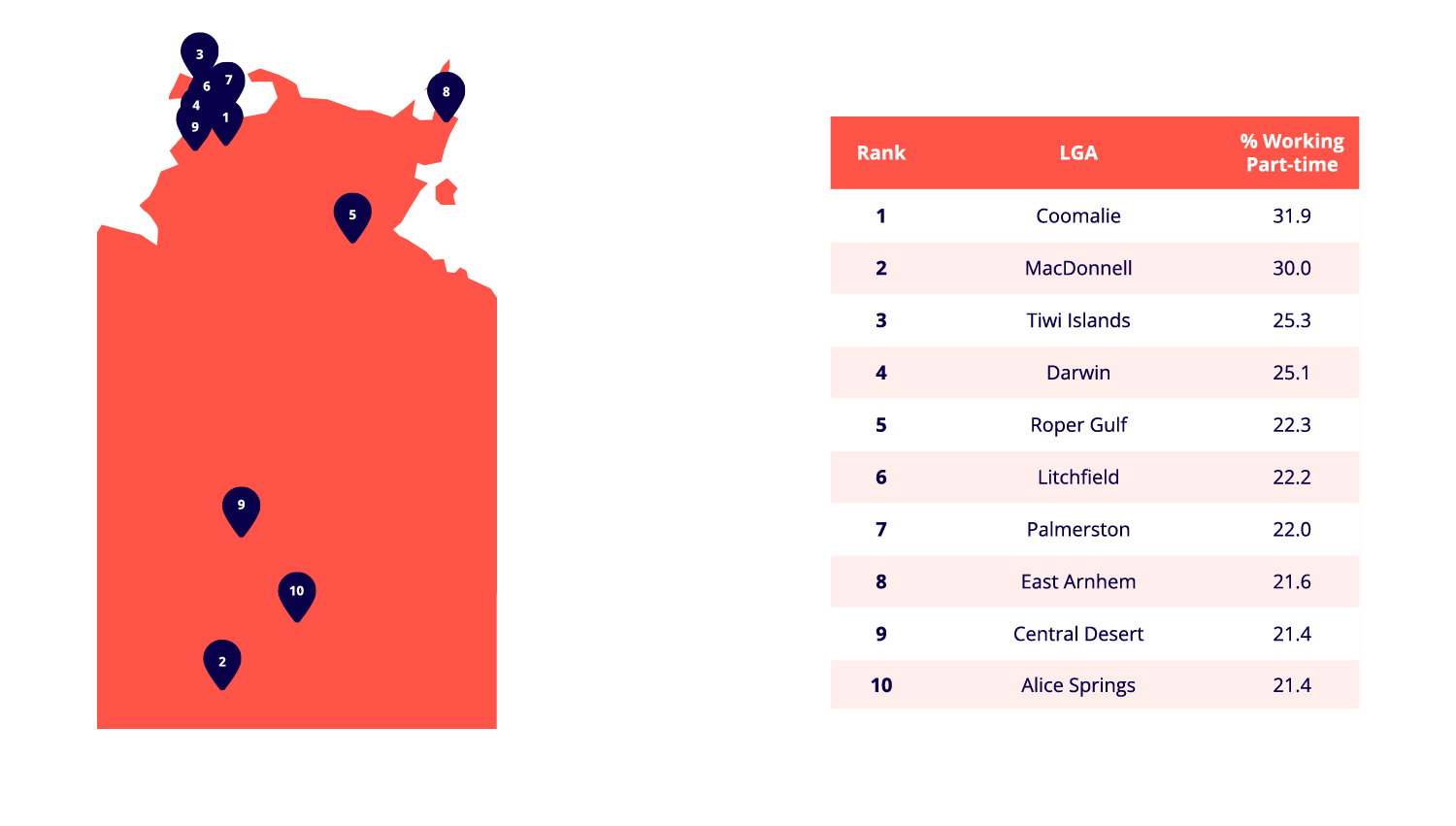
Western Australia
The region of Denmark, famously home to areas of stunning natural beauty such as Greens Pool and Elephant Rocks, is crowned the part-time hotspot of Western Australia. Just over 43% of the population here work part-time. This may be explained by the higher-than-average population of those under 20 and over 50 who typically favour part-time work. Perth suburb Peppermint Grove and popular tourist destination Augusta-Margaret River rank second and third, respectively.

South Australia
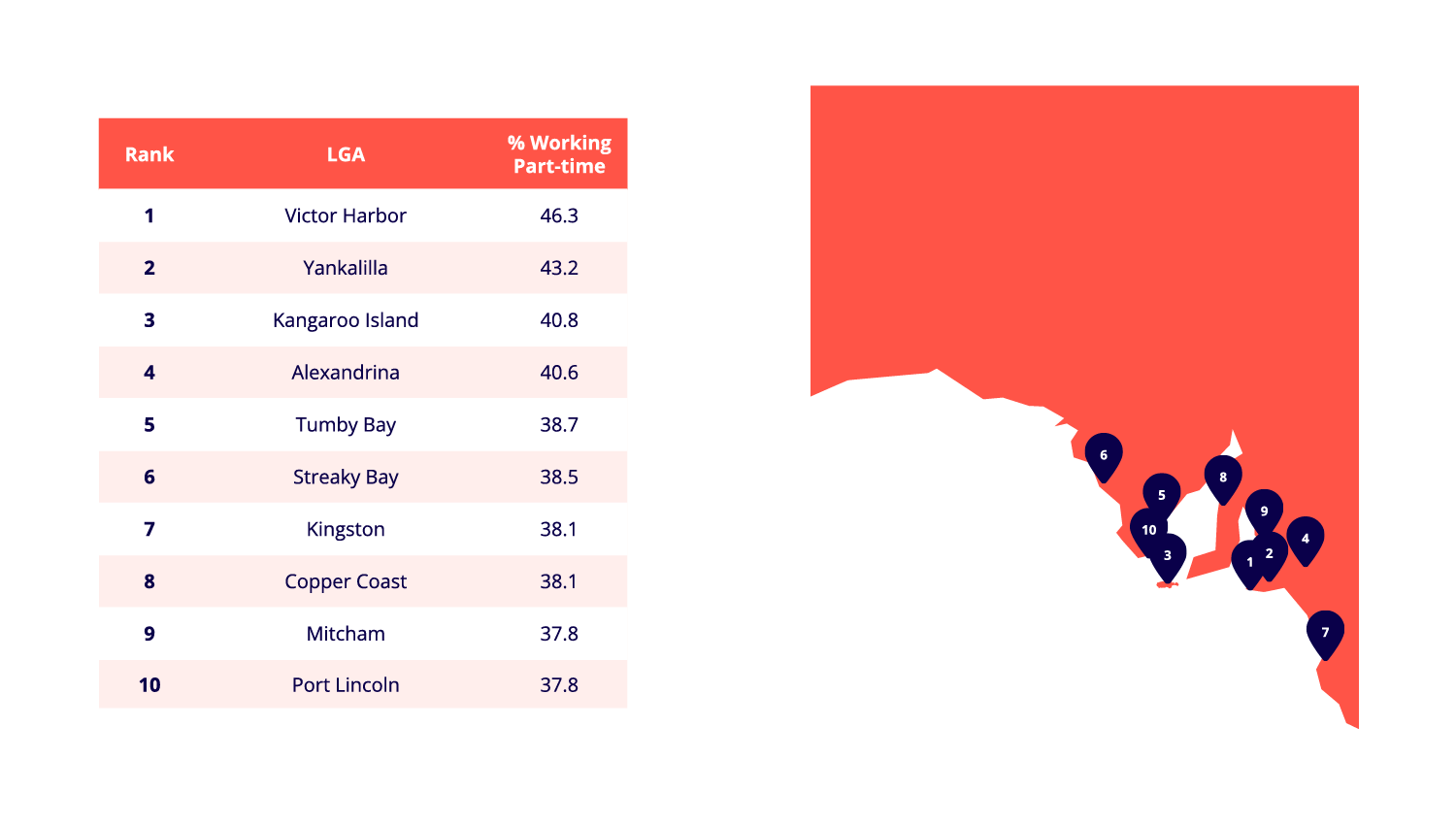
Tasmania
Tasmania has the highest percentage of part-time workers in Australia. Break O’Day ranks first in the state, with 44.6% of workers choosing part-time employment, followed closely by Tasman (44.5%). Both areas are home to a high percentage of hospitality jobs, which typically see more part-time workers. The capital, Hobart, ranks in fourth place. Despite not ranking in the top 10 part-time hotspots, King Island saw the highest increase in part-time worker percentage between 2006 and 2021, rising by almost 25%.
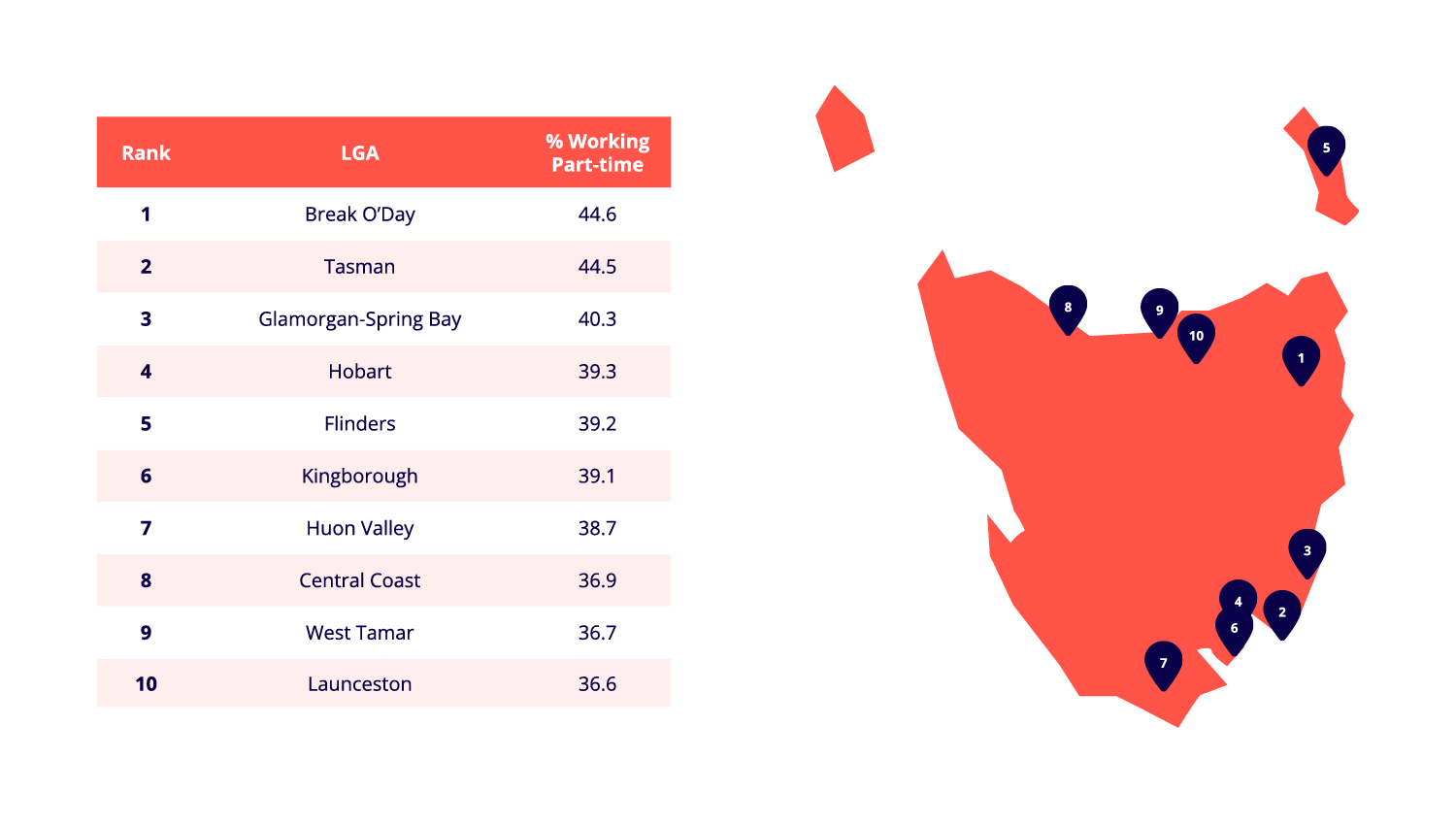
Sydney
Over a quarter of Sydney’s workforce (27.3%) are part-time employees, the second-lowest percentage of all capital cities in Australia. Sydney has the highest cost of living in Australia, which likely restricts people’s ability to work part-time and address their financial needs. The Blue Mountains is the suburb with the highest percentage of part-time workers in the city, over a third (34%) of the workforce here has a part-time role. Sydney has the highest cost of living in the country which restricts people’s ability to work part-time.

Melbourne
The average part-time employment rate in Melbourne is 31.6%, compared to Sydney, which averages 29.7% of people working part-time. South of Melbourne CBD, the Mornington Peninsula has the highest percentage of part-time workers as a proportion of total workers at 36.9%. Whitehorse, in the Eastern Suburbs, follows closely behind with 34.8% of the workforce in part-time employment.

Brisbane
Redland, a coastal, semi-rural locality in Brisbane’s metropolitan area, has the highest percentage of part-time workers in Greater Brisbane at 30.5%, followed closely by Moreton Bay and Brisbane City.
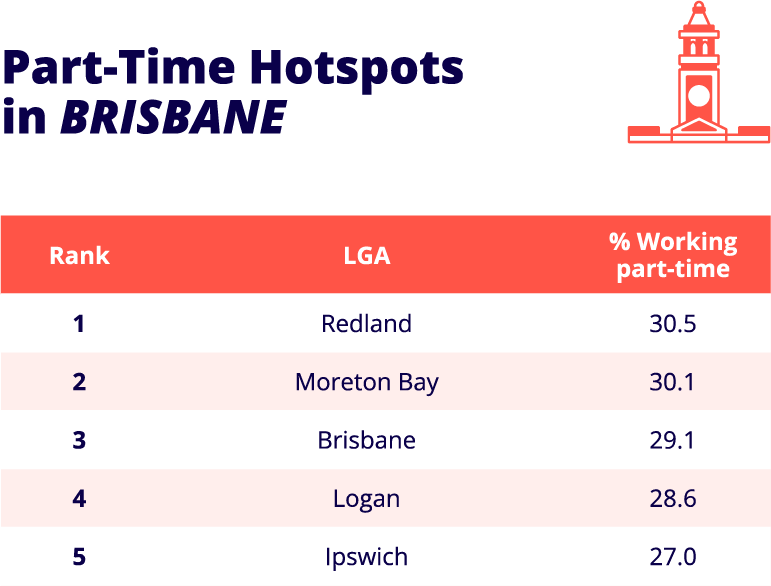
Darwin
Darwin has the lowest percentage of part-time workers out of all state capitals in Australia, with just less than a quarter (23.9%) of the workforce employed part-time. However, some areas of the wider metropolitan area have a much higher rate of part-time employment. Coomalie tops this list, with almost a third (31.9%) of workers taking on part-time roles.

Perth
Almost a third (32.5%) of all workers in Perth work part-time. Peppermint Grove is the area with the highest percentage of part-time employees, with two in five (41.4%) of workers in the area working part-time. Close by, Mosman Park and Nedlands follow in second and third place, respectively.

Adelaide
Adelaide has the second-highest proportion of part-time workers in a capital city, with 35.1% of its workforce engaged in part-time employment. In the adjacent suburbs of Mitcham and Burnside, part-time employment reigns supreme, with over 37% of the workforce opting for part-time roles, marking them as the top part-time hotspots within the city.
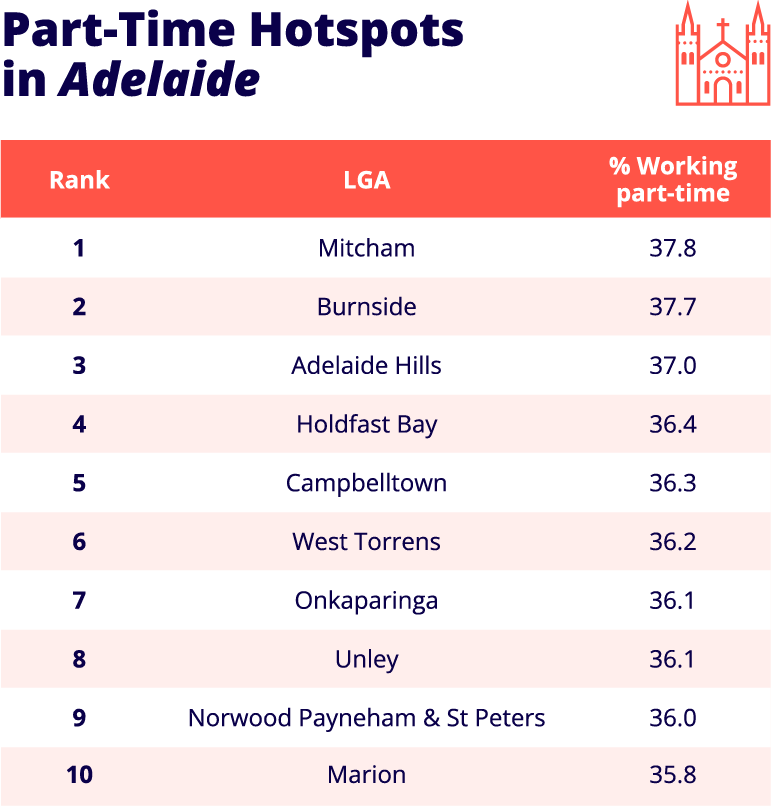
Hobart
Among all state capitals, Hobart’s metropolitan region boasts the highest proportion of part-time workers, standing at 37%. Within the Greater Hobart area, the city itself records the highest percentage of part-time employment, with nearly 40% of its working residents engaged in part-time work.

ABOUT THE DATA
Data provided by The Australian Bureau of Statistics (ABS) in March 2024. Specifically, the data comes from the Census of Population and Housing from 2006, 2011, 2016 & 2021. The results of this study are analysed from data relating to labour force status, gender, age-group and location specific to Local Government Areas (LGAs).
Part-time work is defined as those who usually work less than 35 hours a week and either did so during the reference week, or were not at work in the reference week. Under this definition, persons with more than one job are defined as full-time if they work 35 hours or more across all of their jobs.
LGAs cover legally designated parts of a State or Territory for which incorporated local governing bodies have responsibility. In ABS LGAs, parts of Australia not administered by incorporated bodies are identified as Unincorporated followed by a state or territory suffix – for example Unincorporated ACT. The Australian Capital Territory is not divided into local government areas, so it is regarded as a single “unincorporated” local government area during censusing. Unincorporated LGAs and “No Usual Address” have been filtered, except for Unincorporated ACT in this study.
LGAs with a total eligible working population less than 100 respondents in the 2021 Census have been filtered from Part-Time Worker Hotspots. LGAs with 0 respondents in any of the labour force status categories (full-time, part-time, away from work, unemployed) have also been filtered from the data.
Part-time employment percentage growth is calculated as a percentage change between the proportion of part-time workers in 2021 vs. 2006 according to census data. LGA’s that do not exist in both periods have been filtered for this calculation. LGAs may not have data for all 4 Census periods due to re-categorisation or amalgamation.
Part-time growth is calculated as a percentage change in the number of part-time workers in 2021 vs. 2006 according to census data. LGAs with a population of less than 50 Male part-time workers in the 2021 Census have been filtered when determining LGAs driving the greatest change over time.
City and State aggregation is based on LGA categorisation. For example, calculation for NSW Part-Time workers is based on numbers provided for LGA’s under the designation of NSW, therefore comparisons with data from alternative sources, may yield variations due to differences in data collection or calculation methodologies. City designations have been added to existing ABS data and are comprised of LGA’s located within the greater metropolitan area of each capital city.
Percentages displayed have been rounded to one decimal place. Totals may not equal the sum of components due to rounding.

Download the full report
Discover where in Australia has the highest percentage of part-time workers, and can therefore be known as Australia’s part-time hotspots.

“Reckon Payroll is so easy to use & even gives you your pay slips. I would highly recommend it to any business.”
Curves Gym, Ulladulla
set-up reckon Payroll
Payroll software made for every small business
Manage wages, leave, super and Single Touch Payroll for your employees.
“With more people prioritising flexibility and a good work-life balance, they’re choosing part-time work so they can spend more time with family or focus on other responsibilities outside of work. Then there are those who take on part-time jobs to help with the cost of living.”
– Jess Morris, Reckon General Manager of People & Culture
Related articles

Public holiday pay rates: how to calculate it?
Read more >

6 payroll mistakes to avoid
Read more >

Salary sacrifice explained: payroll guide for employers
Read more >




